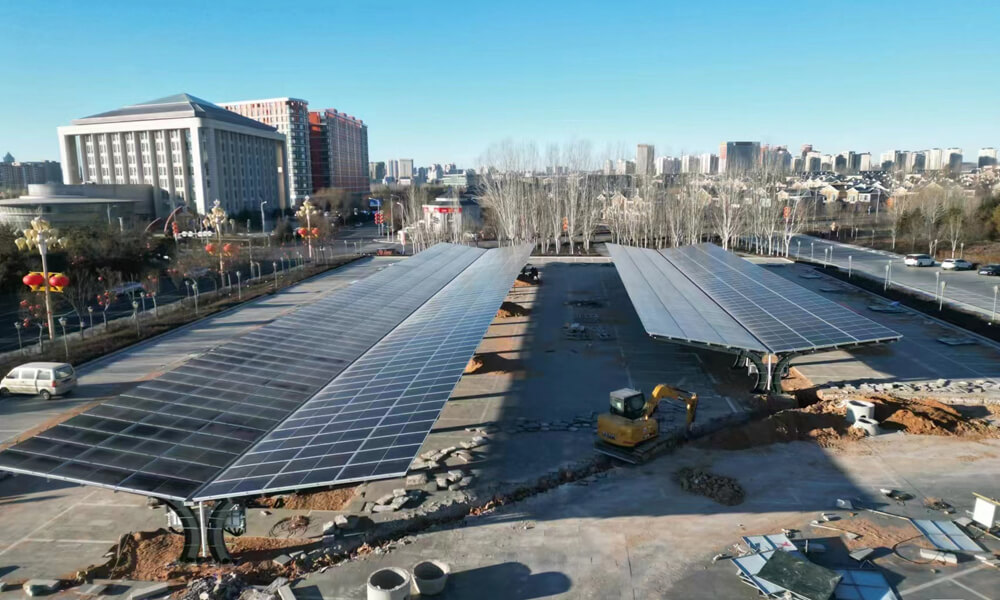The inception of solar carports has revolutionized the concept of renewable energy utilization in our daily lives. Not only do they offer shelter for vehicles, but they also harness the sun’s power to generate electricity. This dual functionality makes solar carports an attractive option for environmentally conscious individuals seeking to reduce their carbon footprint and electricity bills. So we will discover how to build a solar carport with our comprehensive guide.
The benefits of installing a solar carport extend beyond mere energy production. They add value to a property, provide shaded parking, and contribute to environmental sustainability. By turning a standard carport into a power-generating area, homeowners and businesses alike can tap into the untapped potential of their parking spaces.
Table of Contents
1. Understanding Solar Carports
A solar carport, by definition, is a structure that combines the utility of a conventional carport with the renewable energy capability of solar panels. Unlike traditional carports, these innovative structures are designed to capture and convert solar energy into usable electricity, showcasing a blend of functionality and sustainability.
When compared to their conventional counterparts, solar carports stand out not only for their energy generation but also for their contribution to reducing the reliance on fossil fuels. This characteristic distinguishes them as a forward-thinking solution in the realm of renewable energy technologies.
2. Planning Your Solar Carport
2.1 Site Selection for Optimal Sunlight Exposure
Selecting the optimal site for a solar carport hinges crucially on evaluating sunlight exposure. A location bathed in abundant sunlight is paramount for maximizing the energy generation capabilities of the solar panels. This necessitates a thorough assessment of potential shading from nearby structures or natural elements that could impede sunlight access. The goal is to identify a site that remains unobstructed throughout the year, thereby ensuring consistent energy production.
2.2 Space Availability and Carport Orientation
The availability of space is a determinant factor in the feasibility of erecting a solar carport. The chosen site must not only accommodate the carport’s dimensions but also facilitate easy vehicle movement and access. Orientation plays a critical role, as aligning the solar panels towards the south (in the Northern Hemisphere) optimizes sunlight capture. This strategic orientation is vital for maximizing the carport’s energy generation potential.
2.3 Determining Size and Capacity
The process of determining the size and capacity of your solar carport involves a meticulous evaluation of your energy requirements against the backdrop of available space. This step is about striking a balance between your energy production goals and the physical constraints of the installation site. Calculating the number of solar panels needed entails considering the panels’ efficiency, the desired energy output, and how these factors align with your energy consumption patterns and objectives.
2.4 Calculating Solar Panel Requirements
To adequately meet your energy needs, calculating the precise number of solar panels required is essential. This calculation is influenced by the wattage of individual panels and their efficiency, factoring in the total energy output necessary to reach your specified goals. The aim is to achieve a balance that maximizes energy production within the given spatial and structural parameters of the carport.
2.5 Finalizing Carport Dimensions
Finalizing the dimensions of the solar carport is a culmination of the planning process, where the size and capacity considerations are harmonized with your energy goals and the physical landscape of your property. This phase ensures that the carport not only meets your vehicular and energy needs but also complements the aesthetic and functional aspects of your property. Successful planning at this stage lays a solid foundation for the solar carport’s installation and operational efficiency.
3. Design Considerations for Solar Carports
The architectural aesthetics of solar carports should not only complement the existing surroundings but also embody the principles of modern design. This includes the thoughtful integration of solar panels into the structure, ensuring they are both functional and visually appealing.
The choice of solar panel types and their orientation plays a pivotal role in the efficiency of energy generation. Factors such as panel efficiency, durability, and the angle of installation must be meticulously planned to optimize the carport’s energy production capabilities.
4 Legal and Regulatory Compliance
Navigating the legal landscape involves securing the necessary permits and ensuring compliance with local building codes and regulations. This step is vital in avoiding legal complications and ensuring the project adheres to all safety and construction standards.
Grid interconnection requirements are another critical aspect, especially for solar carports intended to feed electricity back into the power grid. Understanding these requirements is essential for a smooth integration process and maximizing the benefits of your solar carport.
5 Choosing the Right Materials
5.1 Framework selection
Selecting suitable materials for a solar carport is critical for ensuring its durability and sustainability. These materials must support the solar panels’ weight and withstand environmental elements, extending the structure’s lifespan.
- Steel: A top choice for its strength and durability, steel provides excellent structural support and corrosion resistance, making it ideal for the carport’s framework.
- Aluminum: Known for its lightness yet strong, aluminum is easy to install and resistant to corrosion, suitable for large-span carports while being eco-friendly due to its recyclability.
- Polycarbonate Roofing: Durable and able to let in natural light, polycarbonate panels withstand environmental stressors, enhancing the carport’s aesthetics and functionality.
- Concrete Foundations: Essential for stability, concrete foundations anchor the carport securely, ensuring longevity against physical and environmental pressures.
By focusing on materials that offer both strength and environmental sustainability, like recycled steel and aluminum and sustainably sourced polycarbonate, the construction of a solar carport can achieve a balance between eco-consciousness and structural integrity.
5.2 Selecting Solar Panels for Optimal Efficiency
The heart of the solar carport lies in its solar panels, making their selection a critical aspect of the planning process. Opting for solar panels involves a thorough analysis of performance criteria, such as efficiency rates, power output, and the technology behind them. The goal is to choose panels that not only align with your energy production targets but also integrate seamlessly with the overall design of the carport. This ensures that the solar carport is not just functional but also a visually appealing addition to your property.
5.3 Compatibility and Performance of Inverters
Inverters play a pivotal role in converting the direct current (DC) generated by solar panels into usable alternating current (AC) for your home or grid. Selecting the suitable inverter involves considering compatibility with the solar panels, efficiency in energy conversion, and reliability over time. The performance of the inverter directly impacts the efficiency of the solar carport’s energy generation system, making it essential to choose an inverter with excellent performance metrics and robust warranty coverage.
5.4 Ensuring Warranty and Support for Long-Term Reliability
Warranty coverage and manufacturer support are vital considerations in the selection of solar panels and inverters. These factors provide a safety net for investment, ensuring that any issues can be addressed promptly without significant cost or inconvenience. Comprehensive warranty coverage is crucial for the carport’s long-term viability. Reliable support aligns it with sustainability and energy independence goals.
6 Installation Process
The installation of a solar carport is a nuanced process that demands precision and specialized skills to ensure the structure’s durability and effectiveness in harnessing solar energy.
6.1 Laying the Foundation:
The installation journey begins with the foundation, a critical element that anchors the entire structure. This process involves digging, setting, and curing concrete to establish a stable base capable of supporting the carport’s weight and withstanding environmental pressures. Accuracy in this phase is paramount to prevent future structural issues.
6.2 Assembling the Framework:
Once the foundation is set, constructing the carport’s framework follows. This step requires assembling steel or aluminum beams into the designated carport shape. Each joint and connection point must be meticulously measured and secured, ensuring the framework’s alignment and stability against environmental forces.
6.3 Securing Solar Panels:
The mounting of solar panels marks a crucial stage in the carport’s installation. This involves attaching solar panels onto the framework with precision to ensure optimal orientation towards the sun for maximum energy absorption. Secure fastening methods are employed to protect panels from detachment or damage due to wind, rain, or snow. Technicians must align each panel to ensure consistent exposure to sunlight, optimizing the carport’s energy production capabilities.
6.4 Finalizing Connections:
The last step involves connecting the solar panels to the electrical grid. This includes wiring the panels, installing inverters, and ensuring that the system complies with local electrical codes. Professional electricians typically handle this phase to guarantee the safety and functionality of the solar energy system.
This detailed approach to each installation phase ensures that the solar carport is not only structurally sound but also maximizes its potential for solar energy production, blending architectural integrity with renewable energy solutions.
7. Electrical Integration
The wiring and electrical connections of a solar carport are intricate components that necessitate professional installation. Proper integration ensures efficient energy transfer and reduces the risk of electrical issues.
Energy storage options, such as batteries, enhance the utility of solar carports by storing excess energy for later use. This capability allows for greater energy independence and resilience, making solar carports a versatile solution for energy management.
8. Cost Analysis and Budgeting
Estimating the costs involved in building a solar carport is essential for budget planning and financial management. This analysis should account for all expenses, including materials, labor, permits, and any additional costs, providing a clear picture of the project’s financial requirements.
Exploring financing options and incentives can significantly reduce the upfront costs of a solar carport. Government rebates, tax credits, and financing programs are available to support renewable energy projects, making solar carports more accessible and affordable.
9. Maintenance and Troubleshooting
Routine maintenance is critical to ensuring the long-term performance and reliability of a solar carport. This includes regular cleaning of solar panels, inspections for structural integrity, and monitoring of electrical systems.
Familiarizing oneself with common issues and their solutions can aid in the swift resolution of problems, minimizing downtime, and maintaining optimal energy production. This proactive approach to maintenance and troubleshooting is essential for the sustained success of a solar carport.
10. Conclusion
The journey to building a solar carport encompasses a series of thoughtful considerations, from planning and design to installation and maintenance. By embracing this innovative approach to energy generation, individuals and businesses can contribute to a more sustainable future while enjoying the practical benefits of renewable energy.
Encouraged by the myriad benefits and armed with the knowledge provided, embarking on the creation of a solar carport represents a step forward in the pursuit of energy independence and environmental stewardship.
















